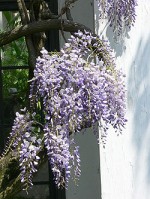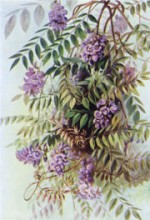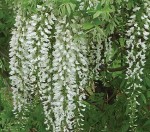

He most common kind of wisteria is Wisteria floribunda, Japanese Wisteria but Chinese Wisteria (Wisteria sinensis) and American Wisteria (Wisteria frutescens ) are also available. The two Asian species are vigorous growers and can easily get out of hand, especially the Chinese species which is considered “ruthless” by some. They can grow over or under a shed or garage in a single season and can emerge in your lawn far from the original planting. On the other hand, their vigorous growth will allow it to cover a pergola or arbor in a couple of seasons. Japanese Wisteria blooms longer than Chinese Wisteria.
The most common problem of the Asian wisterias is their refusal to bloom. The cause is usually one of three possibilities: lack of sun, lack of maturity/age or too much fertilizer.
1. Plant your wisteria in full sun.
2. Buy only named varieties that have been grafted to circumvent lack of matuity. Don’t buy unnamed wisteria unless they are bearing flowers so that you can be assured that your plant is old enough to bloom. Wisteria grown from seed take up to 20 years to bloom so you can get mighty impatient waiting years while watching your monster grow and flourish.
3. Cut back on fertilizer (particularly nitrogen) if you have the plant in full sun and know the cultivar name of your plant.
Cold temperatures can kill buds, but this is unlikely to be the cause of no bloom year after year so unless you know that winterkill has occurred in your area hope for this cause. W. floribunda ‘Alba’ is less susceptible to late-spring frosts.

If you are OK with a wisteria that is much better behaved (i.e. is less vigorous) but does not have as showy flowers try an American native such as Wisteria frustecens. This wisteria grows much more slowly, produces its flowers in short racemes a bit later than the Japanese Wisteria and is a repeat bloomer.
Type: Deciduous vine but can be trained into small tree.
Bloom: White, pink or lavender in racemes before the leaves appear (Japanese and Chinese racemes are much longer than American); Spring (Japanese Wisteria is the earliest, American the latest) Chinese flowers are fragrant.
Size: 20+yards H x 10+ yards spread!!! (American more like 20’ H).
Light: Full sun, partial shade in the South.
Soil: Prefers fertile, moist, well drained but can tolerate much less desirable conditions.
Fertilizer: Apply an organic or slow release fertilizer immediately after flowering the first couple of years but after that give them noting. More fertilizer will cause excessive vegetative growth and decreased flowering.
Hardiness: Zones 5-9.
Care: Prune back side shoots to the basal few buds in early spring to enhance the bloom. Sometimes wisteria can be brought into bloom by abusing the main trunk, root pruning, or drought stress. If you want to decrease the size of the vine, cut back side shoots during mid summer to fall.
Pests and Diseases: None of significance.
Propagation: Hardwood and softwood cuttings; seeds but seedlings take decades to bloom.
Companion plants: The issue here is the support. Sturdy arbors, pergolas, fences and gazebos will look terrific with a well grown, flowering wisteria.
Outstanding Selections:

W. floribunda – Japanese Wisteria (realistically, many of these will be difficult to find but the list gives you in idea of what is possible)
‘Alba’ – white flower
‘Carnea’ – flesh-pink flowers
‘Issai Perfect’ – white flowers, produced while the plant is still young
‘Ivory Tower’ – white flowers, fragrant and numerous
‘Lawrence’ – blue flowers, hardy cultivar
‘Longissima’ – light purple flowers, clusters very long
‘Longissima Alba’ – white flowers in clusters a half-meter long
‘Macrobotrys’ – reddish-violet flower clusters one meter or longer
‘Macrobotrys Cascade’ – white and pinkish-purple flowers, vigorous grower
‘Plena’ – double blue flowers in dense clusters
‘Praecox’ – blue-purple flowers, dwarf variety
‘Purpurea’ – purple flowers
‘Rosea’ – pale rose flowers tipped purple, 18 inches long
‘Royal Purple’ – purple flowers
‘Rubra’- deep pink to red flowers
‘Snow Showers’ – white flowers with a lilac tinge
‘Texas Purple’ – purple flowers, produced while the plant is still young
‘Violacea Plena’ – double violet flowers, rosette-shaped
W. sinensis ‘Cooke’s Purple’
W. fructescens ‘Amethyst Falls’
Comment: According to Wikipedia, “the world’s largest known Wisteria vine is located in Sierra Madre, California, measuring more than an acre in size and weighing 250 tons. “ Now that is a monster plant!

I have wisteria, both purple and white, the unruly kind. I never let it grow on a structure like the house, a tree or a fence. I hack at it almost year ’round. I’m rewarded in the spring with a real show.
I tried the American wisteria but I am a devotee of the long pendulous racemes and think the work is well worth them too. Also, our pergola on the back of the house has a southern exposure so we really wanted shade.
Question – established Wisteria – 30 years old – 100 sq. feet — bloomed profusely for years – this spring as well – but now, suddenly it stopped growing – growth shoots are withering and the leafs have a papery lighter green look — watering patterns are the same as for the last 30 years. Any suggestions??
thanx
Andreas,
I feel for you with your wisteria problem! To have one for 30 years blooming profusely is a treat; the plant must be like an old friend.
Wisteria are pretty tough plants and usually don’t have many problems . You can check for red spider mites that cause a singed look to the leaves but i doubt they would cause as large a problem as you seem to have. There is another problem that comes to mind, crown gall, and I hope you don’t have that. It affects the stems and roots and can be seen at the crown of the root where the soil meets the root system. It is a very serious problem and may kill your plant. You have to remove the infected part of the plant, sterilizing any tools you use so that you don’t spread the disease. And don’t plant any new plants in the area until you have thoroughly removed all signs of the disease. You don’t say where you live but you probably have a country extension agent that would be familiar with the diseases of your area. Take him/her a substantial amount of sick wisteria and a picture of problem areas/the whole plant and you will probably get some more specific advice.
Good luck.
Karen